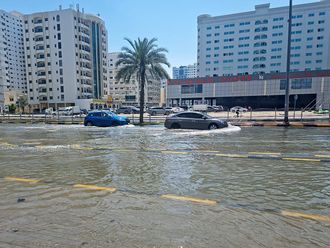Abu Dhabi's western island of Marawah is one of the key centres of archaeology in the UAE, according to the Abu Dhabi Islands Archaeological Survey (Adias), which has just completed mapping of known sites on the island.
"More than 40 archaeological sites or groups of sites have now been identified on Marawah," according to an Adias report released yesterday. Some of these sites are individual ones, but many are large groups of archaeological sub-sites or features, the report stated.
"In one area alone, Site MR-9, we have found around 160 individual fire-pits or hearths. This is one of the highest concentrations of archaeological sites anywhere in the country."
Marawah is important not only because of the number of sites, but also because of the broad range of dates that they represent.
"One of the sites on the island, MR-1, has produced the oldest dates yet recorded by the country, going back to over 7,000 years ago, in the Late Stone Age," the report added.
There are other sites from the Bronze Age, the Iron Age, the late pre-Islamic period and the Islamic period, covering the whole span of human occupation of the Emirates.
"No other area in the country has such a complete record." Marawah is the centre of the recently established Marawah Marine Protected Area (MMPA), which covers over 5,000 square kilometres of offshore waters and islands in Western Abu Dhabi.
The MMPA is managed by Abu Dhabi's Environmental Research and Wildlife Development Agency (Erwda), which works closely with Adias on the protection and documentation of archaeological sites on the islands.
As part of the joint Erwda-Adias plans for managing the MMPA, an Adias team led by its Senior Resident Archaeologist, Dr Mark Beech, has just completed a re-examination of all known sites on Marawah, to update the available mapping.
This will now be incorporated both into the MMPA management plan, and into the Abu Dhabi Environmental Database being prepared by the Erwda. During the Adias survey, a number of previous unrecognised sites were discovered. These included a large Islamic graveyard with over 60 burials, and an important fragment of pottery from the late Stone Age.
"This pottery is of a type made in southern Iraq near Tell Al-'Ubaid, manufactured around 7,000 years ago," Dr Beech said.
"Ubaid pottery has also been found on three other Abu Dhabi islands, Dalma, Ghagha and Al Aryam, and in Northern Emirates, and provides early evidence of the UAE's tradition of maritime trade.
Peter Hellyer, Adias' Executive Director, said: "Our fieldwork on Marawah this season has added important new information about the archaeology of the island. It contains an extraordinarily complete record of human settlement in the Emirates, and we are delighted that the sites are now protected as part of the MMPA."
Majid Al Mansouri, Erwda's Secretary General said: "Erwda has always worked very closely with Adias. We share the same objectives of recording, conserving and protecting the natural and human heritage of Abu Dhabi.
"The MMPA is the flagship of our protected areas programme, and we are delighted that the recent work by Adias has further confirmed the importance of this area."
Adias completes mapping Abu Dhabi treasure island
Adias completes mapping Abu Dhabi treasure island












